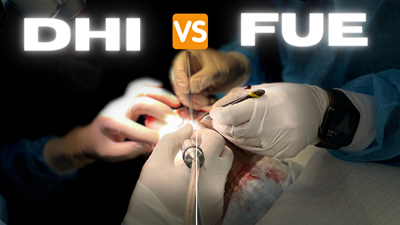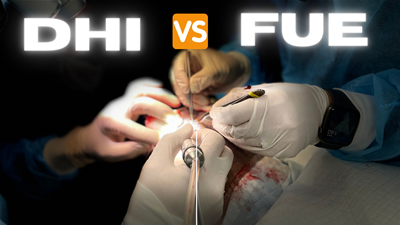 DHI has been hyped all over the internet as a groundbreaking discovery. Hair restoration centers have even used this acronym in their name as a badge or sign of quality. There is a lot of misinformation floating around, and recently many have even pitted these two different techniques against each other, which makes absolutely no sense. I'll explain why.
DHI has been hyped all over the internet as a groundbreaking discovery. Hair restoration centers have even used this acronym in their name as a badge or sign of quality. There is a lot of misinformation floating around, and recently many have even pitted these two different techniques against each other, which makes absolutely no sense. I'll explain why.
What is DHI?
Direct Hair Implantation (DHI) is a method of implantation where follicular unit grafts are implanted directly into the scalp with a technical pen. The technical pen creates the site and implants the graft simultaneously. Traditionally, these recipient sites were created beforehand by the hair transplant surgeon. Once the sites are made, the grafts are placed in a holding solution to keep them moist and keep them from drying and dying. The less time these grafts are outside of the body, the better the survival. At least, that's what conventional wisdom dictates. Therefore, the DHI technique was created to significantly reduce the time the grafts are out of the body.
DHI Hype and Marketing
The DHI technique, when done right, can produce excellent results. When done wrong, the grafts won't grow. The same is accurate with the traditional method of implanting grafts into pre-made slits using forceps. Follicular unit grafts can survive outside of the body for almost twenty-four hours. While minimizing the time reduces the chances of the grafts drying or dying, it doesn't guarantee good results. The DHI technique has been hyped and promoted by clinics as some miracle technique that is fail-proof which isn't true. Some of the world's best and elite hair transplant surgeons don't use this DHI technique, and they continue to produce dense and natural results.
What is FUE?
Follicular unit extraction (FUE) is the method of extraction. Surgeons or technicians use a small punch to remove hair follicles one by one from the scalp. The surgical punches are small, ranging from 0.7mm to 1mm in circumference. Surgeons harvest hair via FUE, as opposed to DHI, which surgeons use to transplant hair. Traditionally, a strip of tissue is removed from the scalp's back and sides and then dissected into follicular units. This method of harvesting is called follicular unit strip surgery (FUSS) or strip. Recently, FUSS has fallen out of favor because of the linear scar. While FUE isn't scarless, the tiny scars are virtually undetectable, even with short hair.
DHI and FUE Are Not Mutually Exclusive
Asking whether DHI is better than FUE is similar to asking whether a washer machine is better than a dryer. They perform different yet vital functions for cleaning clothes. Now, whether DHI is better than traditional pre-made slits is debatable. That said, the techniques aren't as crucial as legitimate reviews and results. If you're interested in researching hair transplant surgeons and their techniques, I strongly encourage you to visit our hair loss forum (Hair Restoration Network).
Conclusion
Not every hair transplant surgeon is created equal. Their techniques vary widely, as do their results. The best place to research surgeons and their techniques is on the hair restoration network forum. But do not make the mistake of researching and consulting with one surgeon. Consult with many. Feel free to use the link below to consult with pre-screened surgeons that have been vetted and approved by our large community of patients and physicians. Research and consult with surgeons here.

